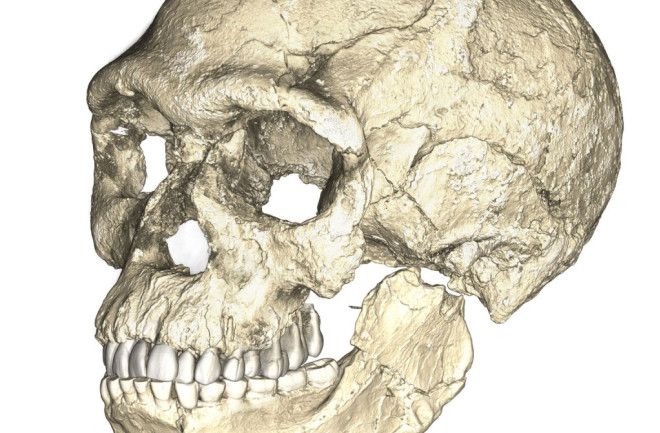One of the earliest known members of Homo sapiens was this guy. The composite image, based on micro-CT scans of fossils from a site in Morocco, shows that the modern human face had already evolved by 300,000 years ago, smashing conventional thinking about our evolutionary timeframe. (Credit PhilippGunz, MPI EVA Leipzig) For decades, based on both the fossil record and, more recently, paleogenomic modeling, researchers have generally put the start date for Homo sapiens around 200,000 years ago. A trove of fossil and artefact finds from Morocco, however, pushes the age of our species back — way back. The new findings have implications far beyond how many candles to put on our collective birthday cake. In 2004, when researchers revisited the previously excavated early hominin site of Jebel Irhoud, about 60 miles outside of Marrakesh, it was a clean-up mission — at first. The mid-20th century mining operations that had turned up the first hominin bones had also destroyed much of the site, and the method in which some of those first finds had been collected made dating them with any confidence a difficult undertaking. The hope in reopening the site was to turn up some undisturbed rock layers that might help researchers establish a more conclusive age for the previously discovered fossils. But Jebel Irhoud was not finished sharing its secrets. The researchers found an area of the site that had been preserved, and discovered more fossils — from at least five individuals — plus numerous stone tools and other artifacts, some of which appeared to have been heated in a controlled fire. While the bones may get all the headlines, these bits of flint, apparently flaked off into the fire as tools were sharpened, are just as important: The material was perfect for dating using the thermoluminescence method. The results were startling: Most of the fossils and tools are about 300,000 years old. That's a date on the calendar about 100,000 years before any Homo sapiens should be out and about. "The dates were a big wow," said lead researcher Jean-Jacque Hublin, of the Max Plank Institute for Evolutionary Anthropology in Leipzig, at a Tuesday press briefing. "Early in the process we realized the site was much older than anyone could have imagined." The researchers at Jebel Irhoud had unearthed multiple individuals forming the earliest known population of Homo sapiens, 100,000 years older and more than 3,000 miles from the site that yielded the previous winner in the Who's Our Daddy? contest. Or, as Hublin said of the Jebel Irhoud fossils, "This material represents the very root of our species." The findings, published as two papers — one on the fossils and the other on associated stone tools and the dating methods involved — and an accompanying News & Viewsarticle, appear today in Nature. The Face of Us The newly described Jebel Irhoud hominins — at least three adults, one adolescent and a child the researchers believe was about 8 years old at time of death — have an intriguing mix of traits. Their faces were essentially ours: "It’s the face of people you could cross in the street today," says Hublin of the best preserved Jebel Irhoud partial skull. While some of the fossils had larger brow ridges, their facial feature measurements fall within the range of modern humans. Seen in profile, however, a key difference is apparent: although it had a volume "in the range of modern humans," according to Hublin, the Jebel Irhoud hominin braincase was lower and more elongated. Based on preserved features of the braincase (the part of the skull that encases, yep, the brain), the researchers believe the Moroccan hominins had a smaller cerebellum than modern humans, though not as small as that of Neanderthals. The cerebellum has been linked to fine motor skills as well as creativity; while the Jebel Irhoud hominins might have gone unnoticed walking down a city street today, it's likely that none of them would have had an Etsy shop. More seriously, however, finding early Homo sapiens with modern faces and teeth but more primitive braincases refines our understanding of the actual process of human evolution. “The story of our species in the last 300,000 years is the story of our brain’s evolution,” said Hublin, who added that mutations likely built up over that period, changing the brain's functional abilities along with its shape and giving the species cognitive advantages in everything from creating better technology to managing social complexities.
Meet The New Oldest Homo Sapiens — Our Species Evolved Much Earlier Than Thought

Newsletter
Sign up for our email newsletter for the latest science news
0 free articles left
Want More? Get unlimited access for as low as $1.99/month
Stay Curious
Sign up for our weekly newsletter and unlock one more article for free.
View our Privacy Policy
Want more?
Keep reading for as low as $1.99!
Already a subscriber?
Find my Subscription
More From Discover
Recommendations From Our Store
Shop Now
Stay Curious
Subscribe
To The Magazine
Save up to 40% off the cover price when you subscribe to Discover magazine.
Copyright © 2024 Kalmbach Media Co.

